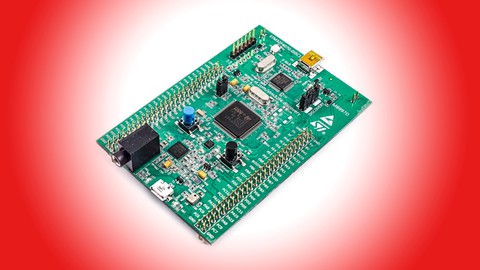
STM32 bare metal guide for future embedded projects (part 1)
STM32 bare metal guide for future embedded projects (part 1), available at $69.99, has an average rating of 4.09, with 34 lectures, based on 26 reviews, and has 122 subscribers.
You will learn about Memory map and what are the parts of memory Use pointers to edit data in memory Different ways to access and edit data in memory Bitwise operations on data Endianness of a device Understanding GPIO and going through output and input Understanding NVIC and triggering interrupts Understanding the SYSCLK and going through its configuration Understanding the TIMER and going through its various functionalities Understanding DMA and going through its functionality This course is ideal for individuals who are Students and beginners to embedded systems It is particularly useful for Students and beginners to embedded systems.
Enroll now: STM32 bare metal guide for future embedded projects (part 1)
Summary
Title: STM32 bare metal guide for future embedded projects (part 1)
Price: $69.99
Average Rating: 4.09
Number of Lectures: 34
Number of Published Lectures: 34
Number of Curriculum Items: 34
Number of Published Curriculum Objects: 34
Original Price: $22.99
Quality Status: approved
Status: Live
What You Will Learn
- Memory map and what are the parts of memory
- Use pointers to edit data in memory
- Different ways to access and edit data in memory
- Bitwise operations on data
- Endianness of a device
- Understanding GPIO and going through output and input
- Understanding NVIC and triggering interrupts
- Understanding the SYSCLK and going through its configuration
- Understanding the TIMER and going through its various functionalities
- Understanding DMA and going through its functionality
Who Should Attend
- Students and beginners to embedded systems
Target Audiences
- Students and beginners to embedded systems
This course was created mostly for students, but also for people wishing to start their career on this path to gain general knowledge of embedded systems.
When starting with embedded systems, from my experience and the experience of others, the problem is that there are many unclarities when it comes to reading the documentation and schematics, and later on combining it with programming at the beginning of their studies or research.
This course was made exactly to bridge those gaps and give them insight how simple it is to achieve many functionalities, all by going step-by-step through the reference manual, schematics and programming the device. During the course, all the concepts will be graphically explained. I think that visual learning is the best way of learning.
Because this field is such that just by talking you can’t reach lot, so you must show some results, at the end of every important step, an experiment will be conducted to show the proof. This can also help students or employee beginners with their projects. The device that was used in this course is the STM32F407VG discovery board.
The only libraries and instructions that are used in this course, are the ones that can be used on any other C compiler. Everything else is self-made. The course content is kept minimalistic.
During the course you’ll learn about:
– Memory access and editing
– General Purpose Input Output (GPIO)
– Interrupts
– Nested Vector Interrupt Controlelr (NVIC)
– Clocks (HSI, HSE, PLL)
– Timers (and functionalities)
– Direct Memory Access (DMA)
I’m open to feedback on:
– what was explained well?
– what wasn’t?
– where to put more emphasis on?
– is something missing?
– what would you like to see but was not covered? (it can also be something unrelated to the given topics)
The feedback is optional, it’s supposed to be less about me, but more about others.
Those who decide to share their opinion, I would ask for constructive feedback, because that way I can consider it and make new courses better and more understandable for future viewers.
For the first 30-days I’m open to answering all questions regarding the course
Course Curriculum
Chapter 1: Introduction
Lecture 1: Introduction
Chapter 2: IDE Installation and setup
Lecture 1: Keil uVision Installation
Lecture 2: Setup Keil uVision for STM32
Chapter 3: Memory
Lecture 1: General overview of memory
Lecture 2: Memory map and address ranges
Lecture 3: Assigning 1 byte data to memory
Lecture 4: Bitwise operation on data
Lecture 5: Assigning two- and four-byte data to memory
Lecture 6: Assigning structure object to memory
Chapter 4: General Purpose Input Output (GPIO)
Lecture 1: Introduction to GPIO
Lecture 2: GPIO memory space
Lecture 3: GPIO output configuration using pointer
Lecture 4: GPIO output configuration using macro
Lecture 5: GPIO output configuration using structure pointer
Lecture 6: GPIO input configuration
Lecture 7: GPIO input configuration using interrupt – theory
Lecture 8: GPIO input configuration using interrupt – programming
Chapter 5: Nested Vector Interrupt Table – NVIC
Lecture 1: NVIC – Theory
Lecture 2: NVIC – Programming experiment
Chapter 6: Timers
Lecture 1: Clocks and timers
Lecture 2: Timer interrupt – Theory
Lecture 3: Timer interrupt – Programming experiment
Lecture 4: PWM Output – Theory
Lecture 5: PWM Output – Programming experiment
Lecture 6: Input capture – Theory
Lecture 7: Input capture – Programming experiment
Lecture 8: PWM input – Theory & Programming experiment
Lecture 9: Reading ultrasonic sensor
Lecture 10: Encoder – Theory
Lecture 11: Encoder – Programming experiment
Lecture 12: PLL – Theory & Programming experiment
Chapter 7: Direct Memory Access – DMA
Lecture 1: DMA – Theory
Lecture 2: DMA – Programming experiment
Chapter 8: End of part 1
Lecture 1: Ending video
Instructors
-
Boyan Lazic
Instructor
Rating Distribution
- 1 stars: 2 votes
- 2 stars: 0 votes
- 3 stars: 4 votes
- 4 stars: 13 votes
- 5 stars: 7 votes
Frequently Asked Questions
How long do I have access to the course materials?
You can view and review the lecture materials indefinitely, like an on-demand channel.
Can I take my courses with me wherever I go?
Definitely! If you have an internet connection, courses on Udemy are available on any device at any time. If you don’t have an internet connection, some instructors also let their students download course lectures. That’s up to the instructor though, so make sure you get on their good side!
You may also like
- Top 10 Financial Technology Courses to Learn in December 2024
- Top 10 Agile Methodologies Courses to Learn in December 2024
- Top 10 Project Management Courses to Learn in December 2024
- Top 10 Leadership Skills Courses to Learn in December 2024
- Top 10 Public Speaking Courses to Learn in December 2024
- Top 10 Affiliate Marketing Courses to Learn in December 2024
- Top 10 Email Marketing Courses to Learn in December 2024
- Top 10 Social Media Management Courses to Learn in December 2024
- Top 10 SEO Optimization Courses to Learn in December 2024
- Top 10 Content Creation Courses to Learn in December 2024
- Top 10 Game Development Courses to Learn in December 2024
- Top 10 Software Testing Courses to Learn in December 2024
- Top 10 Big Data Courses to Learn in December 2024
- Top 10 Internet Of Things Courses to Learn in December 2024
- Top 10 Quantum Computing Courses to Learn in December 2024
- Top 10 Cloud Computing Courses to Learn in December 2024
- Top 10 3d Modeling Courses to Learn in December 2024
- Top 10 Mobile App Development Courses to Learn in December 2024
- Top 10 Graphic Design Courses to Learn in December 2024
- Top 10 Videography Courses to Learn in December 2024






















